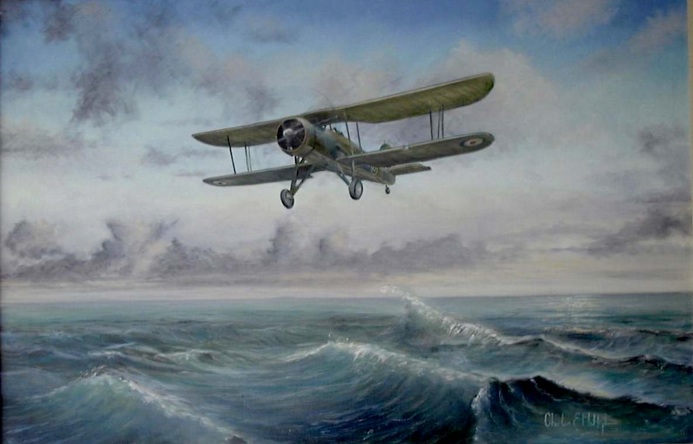11 November 1941

[Swordfish painting by Chas McHugh - see Link below]
On 11 November, Dad had been five months with 830 Squadron in Malta. Two merchant vessels were seen off Pantellaria - a small island 140 miles north-west of Malta, which the Italians had made into a base. Dad and another pilot had already flown four nights running, against the two-nights-on-one-off rota. But General Auchinleck was within days of launching his desert offensive, and supplies to Rommel had to be stopped. So when a new plane arrived that day, the two pilots tossed a coin.
Poolman notes, "The battle of the Libyan convoys was increasing in intensity and importance all the time, and over the three days of November 7th, 8th and 9th reached a peak." On the 7th, Dad was among the four Swordfish which searched into the small hours for a 4000-ton merchant ship 180 miles from Malta. Bad weather over the target area defeated them and they returned with their torpedoes. On the 8th, they hunted Italian submarines protecting a large convoy from Naples, which was attacked by RAF Blenheims and the Royal Navy. Then on the 9th, there was dramatic news of an Italian battleship and her escorts off Messina. Poolman writes, "Eight Swordfish, a maximum effort for 830 at this time, took off with their torpedoes, looking for their own 'Sink the Bismark!' epic. But the squadron's current run of bad luck held, and they all returned with their torpedoes." Then came November 11.
A howling gale was blowing when they took off at 2100. The dispersal bus was late picking up the crews, and the Wellington captained by Tony Spooner, which had identified the target, had used up its fuel and turned for home. Dad remembered nine aircraft in the flight, though Myles Osborn in his account recalled seven - a flare dropper with ASV (radar) and six planes armed with torpedoes. Accounts also differ on what happened next, and this one is mainly from Dad's papers.
Swordfish Mk1s did not have enough power to carry the heavy torpedo and a navigator with ASV, so the armed planes flew in formation through the night behind their unarmed leader. As Senior Pilot, Osborn flew the lead aircraft with the observer CO navigating and Sgt Parke TAG. The planes had no radio transmission between them and relied on a basic Morse code system. Osborn was not immediately aware that three planes, piloted by Thorpe, Vercoe and O'Brien, had returned to base with mechanical problems.
Four Swordfish flew on in the worsening weather. Rain squalls lashed their open cockpits beneath a cloud base of 500 feet. The CO noticed a change in wind direction before reaching Lampedusa, which would reduce their ground speed by about 30 knots. He set a new course and an hour or so later an island appeared through the murk. From here another course was set for Pantellaria, and then, some time later, their ASV (air-to-surface-vessel) radar stopped working. They were now dependent on the ASV Wellington to find the convoy, unaware that Spooner had already turned for home.
The Estimated Time of Arrival for Pantellaria passed without sight of it, and Osborn's concern grew about their position. The four planes closed formation and climbed through cloud to 4000 feet, where their TAGs tried to raise Malta. There was no response, and the latent menace in the night was fast becoming apparent.
(Continued)
Links: Next Page Chas McHugh
